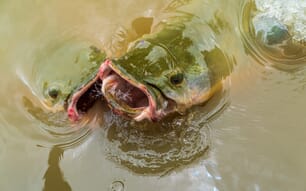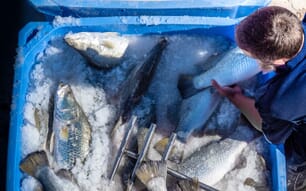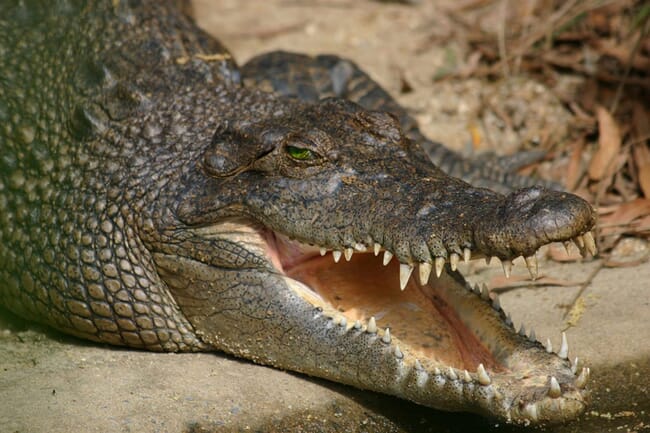
The reptiles collectively referred to as crocodilians (order: Crocodylia) are found naturally in tropical and sub-tropical regions throughout the world. Altogether, there are some 27 species in three related families: the Crocodylidae, Alligatoridae and Gavialidae. It is believed that alligators and crocodiles diverged from a common ancestor some 80 to 100 million years ago, with the gavials splitting off sometime later. All crocodilid and aligatorid species are listed under the Convention on International Trade in Endangered Species of Wild Fauna and Flora (CITES), but many are exported and imported throughout the world. Most are utilised for their leather products, but some are also raised for meat.
Farming and ranching efforts began for several crocodilian species in the 1950s in response to widespread declines in wild populations. Once the Convention on International Trade in Endangered Species (CITES) was established in the mid-1970s, interest in farming and ranching crocodilians increased in many countries.
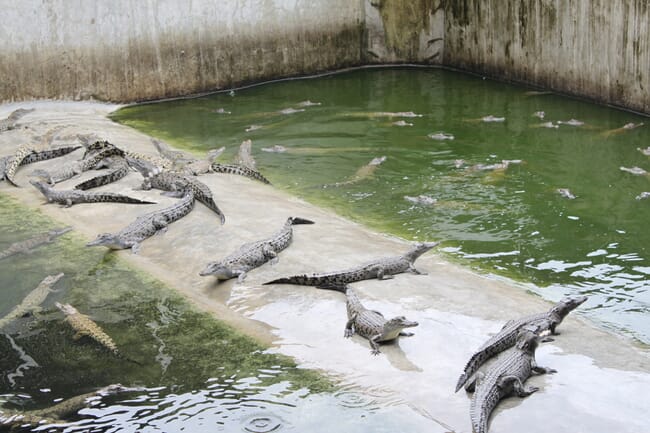
Among nine crocodile species used for food around the world, only the Nile crocodile (Crocodylus niloticus) and the New Guinea crocodile (C. novaeguineae) are considered by the International Union for the Conservation of Nature (IUCN) to have stable wild populations and low-concern conservation status. These and three other species with stable populations and low conservation concern, the mugger (C. palustris), the saltwater crocodile (C. porosus) and Morelet’s crocodile (C. moreletii) are reported among the nine species used commercially for fashion apparel and accessories. Global crocodilian trade also includes alligatorids, most notably the spectacled caiman (Caiman crocodilus), American alligator (Alligator mississippiensis) and the broad-snouted caiman (C. latirostris). All of these species have stable or increasing populations and are used for both human consumption and fashion apparel and accessories.
Farming practices
There are two strategies for obtaining crocodilian hatchlings for grow-out. While some operations have on-farm reproduction, most rely on collecting eggs from the wild, a concept referred to as ranching. In most cases, ranching actually serves to enhance wild populations because it provides an incentive for landowners to manage and maintain private lands to provide optimal habitat for resident crocodilians.
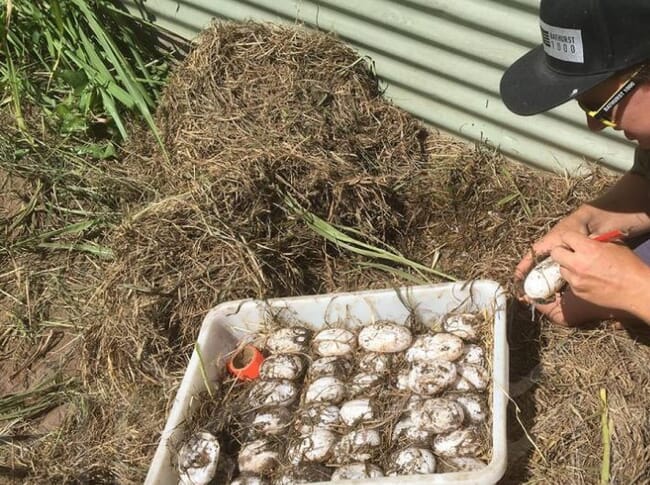
Ranching also involves returning a portion of the resulting hatchlings to their original habitat at some point in the production cycle. The number of eggs that may be collected is usually based on a survey (occasionally aerial) of nests, along with the general condition of the habitat to be collected from. The number of animals to be returned to the wild is calculated based on the percentage of the collected eggs that would have hatched and survived under natural conditions to the size and age at which they will be released. While captive breeding is common for several crocodile species in various parts of the world, the Louisiana alligator industry is a widely cited example of ranching, based on annual egg collection from nests in the wild and subsequent grow-out under controlled farming conditions.
Most crocodilian species reproduce once a year, taking their cues from environmental factors. Males often become aggressive and territorial, as do females in some species. Aggressive encounters sometimes result in death, so if breeding is to take place in a captive setting the habitat should be designed to minimise interactions between males. In captive breeding most species require a fair amount of space, and exhibit some courtship interactions. A combination of ponds (1 to 2 metres in depth) and elevated nesting areas are required, as well as abundant nesting material for some species (grass and other accessible vegetative material). Alligatorids pile up mounds of vegetation in which to lay their eggs, and the slow decomposition of the nest material helps keep the eggs warm. In contrast, some crocodilids simply lay their eggs in mud or sand, more like a turtle or tortoise would.
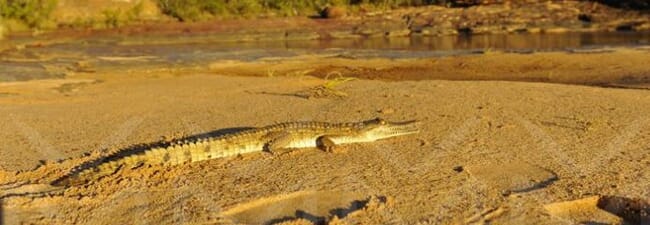
Egg-laying takes place several weeks to several months after mating, depending on the species and – as is the case with some turtle species – some crocodilian females are oblivious to their surroundings while laying their eggs. Depending on the species and size of the female, anywhere from 20 to 60 eggs can be found in a typical nest. Incubation may take from 9 to 14 weeks, depending on species and temperature.
The farming principles for all crocodilian species are pretty straightforward: keep them warm, keep them clean, keep them calm and keep them well fed. Standing water must be accessible for all animals at all times, and exchanged regularly. Dirty water contributes to poor health and a number of potential problems with hide quality. Behaviour and feed consumption must be monitored daily, with minimal disturbance. As a result of all these requirements, raising crocodilians is generally time-consuming, expensive and labour-intensive.
While some small-scale producers in developing countries still utilise raw animals and fish as primary feeds the larger, more efficient farms use high-protein floating pellets. Most crocodilian hatchlings use up their yolk reserves within a few days, at which time they will readily accept appropriately sized pellets. Hatchlings must be fed daily, but as they grow feeding can be reduced to six days per week if necessary.

Crocodilians require high-protein diets, but just how high is often up for debate from an economic standpoint. When excess protein is fed, unused protein is converted to fat and the resulting nitrogen is excreted. One large feed producer in Zambia recommends the following feeding programme for crocodiles:
Age in Months | % Protein Diet |
0-3 | 65 |
0-6 | 60 |
7-18 | 55 |
19-24 | 50 |
24+ | 45 |
When raised indoors, the impacts of high-protein diets on water quality, and indirectly on skin quality, are important considerations. Higher protein diets result in higher ammonia levels in grow-out facilities. An American alligator study at Louisiana State University illustrated the trade-offs. After 180 days of grow-out average body weight and chest girth of juveniles fed a 45 percent protein diet did not differ significantly from those fed a 55 percent protein diet. Aqueous ammonia concentrations in the 45 percent protein treatment were significantly lower than in the 55 percent protein treatment. There was also a notable reduction in ammonia concentrations at the air-water interface in the 45 percent protein treatment, and this is where a substantial amount of hatchling and juvenile respiration takes place. Results suggested that the same growth, and better water and air quality, could be produced with a lower-protein, lower-cost diet than the industry standard 56 percent formulation. Most alligator growers now shift to a 45 percent protein diet after the first few months of growth.
Higher stocking densities generally result in little reduction in growth or condition in some crocodiles, but increased aggressive interactions tend to result in lower skin quality as a result of scarring and bite marks. Some species are more docile than others, so the recommended densities during grow-out vary accordingly. One particularly important limitation on the number of animals in a given area is the tendency for crocodilians to pile on top of each other when frightened, with those on the bottom suffering from compression and even dying occasionally due to suffocation.
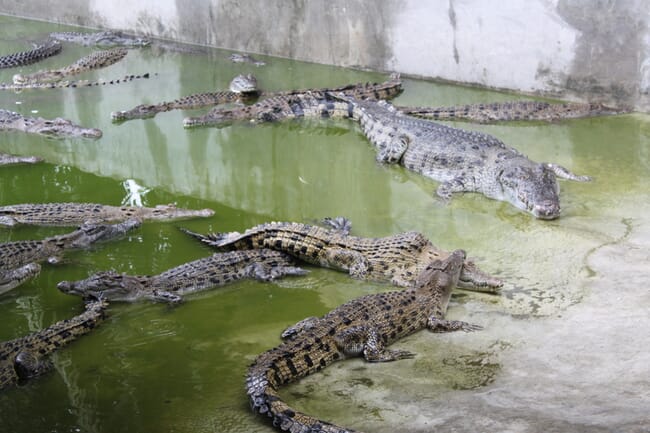
As is the case in most aquaculture and livestock industries, diseases can occasionally result in catastrophic losses of farmed crocodilians. Crocodilepox virus has been found in saltwater crocodiles, occasionally causing significant economic losses. The virus causes skin lesions, which reduce hide values, and extend the production period as well. Poxvirus lesions have also been reported in various caimans and other crocodile species. If a producer delays harvesting in the hopes of giving the lesions time to heal, the potential for spread to other individuals and/or increasing viral loads within already infected animals increases.
Chlamydial and herpesvirus infections have been identified with significant mortality of farmed Siamese crocodiles (C. siamensis), freshwater crocodiles (C. johnstoni) and saltwater crocodiles, and both pathogens are associated with coinfection. Pathology involves both conjunctivitis and pharyngitis (herpesvirus), and systemic infection of the liver, spleen, kidney, heart and respiratory system (Chlamydia), resulting in up to 100 percent mortality in hatchlings and juveniles. Other bacteria, such as Providencia rettgeri and Edwardsiella tarda, have been shown to opportunistically infect several crocodilian species, resulting in septicaemia.
Many crocodilians have also been shown to be particularly susceptible to West Nile virus. And while the virus may not cause significant mortality in some cases, it can have detrimental impacts on hide quality. Exposure to this virus has been strongly associated with subsequent lymphohistiocytic proliferative syndrome (LPS) in American alligators. LPS causes skin blemishes, observable as small (1-2 mm) grey spots, especially on the underbelly, and also affects other tissues. And, while alligator farmers go to great lengths to keep mosquitoes out of their grow-out facilities in Louisiana, recent research indicates that saltwater crocodiles can spread West Nile virus among themselves, even in the absence of any mosquitos, with resultant skin lesions.
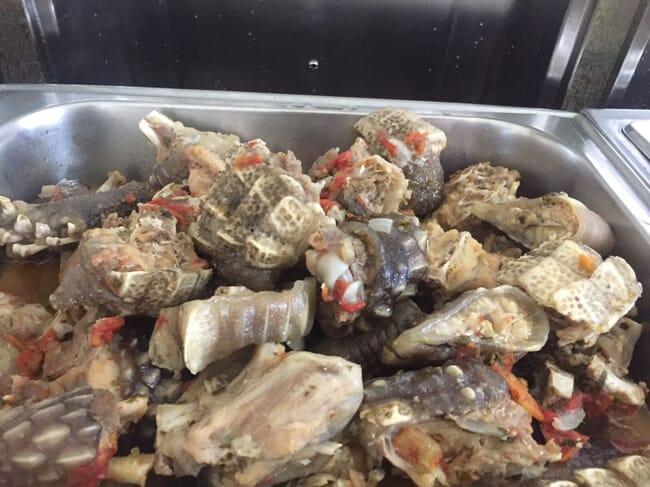
© Greg Lutz
Feeding and maintenance go on routinely in crocodilian farming until animals reach marketable size. At harvest, large farms typically euthanise their animals humanely, using equipment developed for livestock. Smaller, less sophisticated operations often use firearms to kill their animals in the most humane way possible. In recent years the market demand for farmed crocodilian skins has focused on manufacture of watch straps and small leather products. This requires an animal between 90 and 125 cm in length, but the market is gradually shifting to accommodate somewhat larger animals.
As is the case with most global livestock production, a continuum of quality of care can be found in crocodilian husbandry, from subsistence level farms to large commercial operations. A set of farming standards and a certification programme are now in place to promote responsible farming and stewardship of crocodilians. Both are overseen by the International Crocodilian Farmers Association (ICFA), a professional organisation with members in several countries.
Despite differences in production methods for different species and farm operations, crocodilian farmers view their stocks as valuable assets and strive to maintain conditions that minimise disease and optimise growth rates. Nonetheless, escapes are common occurrences because crocodilians are adept at burrowing and climbing, and are surprisingly intelligent.
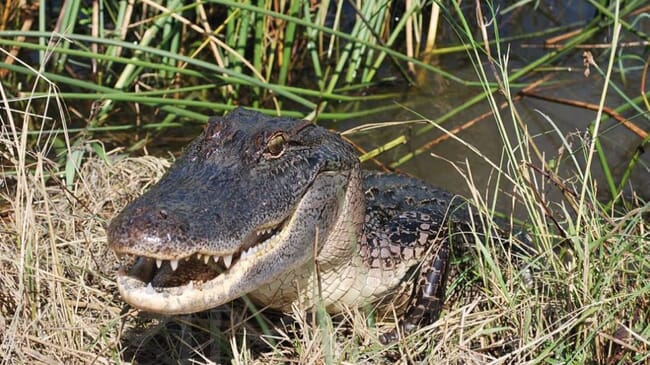
In 2012, some 70 crocodiles escaped from a farm in Israel, a paltry number compared to the escape of some 15,000 crocodiles from a farm in South Africa in 2013 due to flooding on the Limpopo River. And an undocumented number of caimans escaped from a farm in a favela of Rio de Janeiro in 2019 following widespread flooding. In March 2021 a mass escape took place through a broken fence at a farm in western South Africa. And in June, several dozen crocodiles escaped from a farm in Thailand, also as a result of floodwaters. Escapes have also been reported from a number of other countries, including Vietnam and China.
Crocodilian products are considered luxury goods in most parts of the world. Global trade in crocodilian hides peaked around 2013, at a reported level of 1.9 million animals, declining to 1.0 - 1.4 million more recently. Demand generally reflects global economic trends, and the downturn created by the recent pandemic has slowed trade and production considerably. Only time will tell to what extent the industry recovers, and how quickly.


